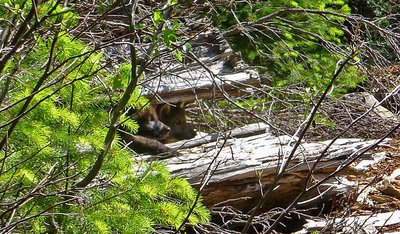
It’s been a good month for gray wolves so far: The Oregon Department of Fish and Wildlife documented new wolf pups in southern Oregon, and just across the border, the California Fish and Game Commission just voted to protect gray wolves under the California Endangered Species Act. The pups were fathered by Oregon’s famous OR-7 and are the first pups to be born in the Oregon Cascades since the 1940s.
OR-7, aka Journey, achieved national fame in 2011 when he left the Imnaha pack in northeastern Oregon to travel all the way to northern California, before heading back up to southern Oregon in the Rogue River Siskiyou National Forest region. With the help of a GPS collar, ODFW biologists have tracked OR-7 on his wanderings.
“This is an incredible development, and it really opens the door for comprehensive wolf recovery, not just throughout Oregon but into northern California, where the wolf will reoccupy,” Josh Laughlin of Cascadia Wildlands says. “This documentation is incredibly exciting. We are in the midst of an incredible wildlife recovery success story here in Oregon and the rest of Cascadia.”
This makes California’s voting decision rather timely, as Cascadia Wildlands and other wolf advocate groups in California gear up for the possibility of wolves in northern California.
“As the population grows and we move from year to year, wolves will continue to be recognized as another species in the landscape,” Laughlin says. “They generate a lot of emotions from a lot of different sides, but given enough time and human tolerance, wolves are going to do just fine regarding habitat in Cascadia.”
Congressman Peter DeFazio has been working towards that human tolerance in Washington, D.C., recently writing a letter asking for the U.S. Fish and Wildlife Service to nullify their proposal to delist the gray wolf, citing an independent peer review that stated USFWS did not use the “best available science,” according to DeFazio’s letter.
“Because it is not based on the best available science, the proposed rule undermines decades of conservation work done to protect the gray wolf, and sets a bad precedent for future ESA delistings,” DeFazio writes. “The service’s claim in the proposed rule that the gray wolf has recovered and should no longer be listed as endangered hinged on the purported existence of a distinct eastern wolf. The peer review report found that the existing scientific literature provides absolutely no basis for this conclusion.”
As always, the political battle continues while the wolves do their best to survive, made evident by the latest four or six new pups.
“The big question is what can we do to coexist on the landscape now that wolves are back,” Laughlin says. “We’ll continue to work on answers to that as gray wolves reoccupy their rightful place on the landscape.”